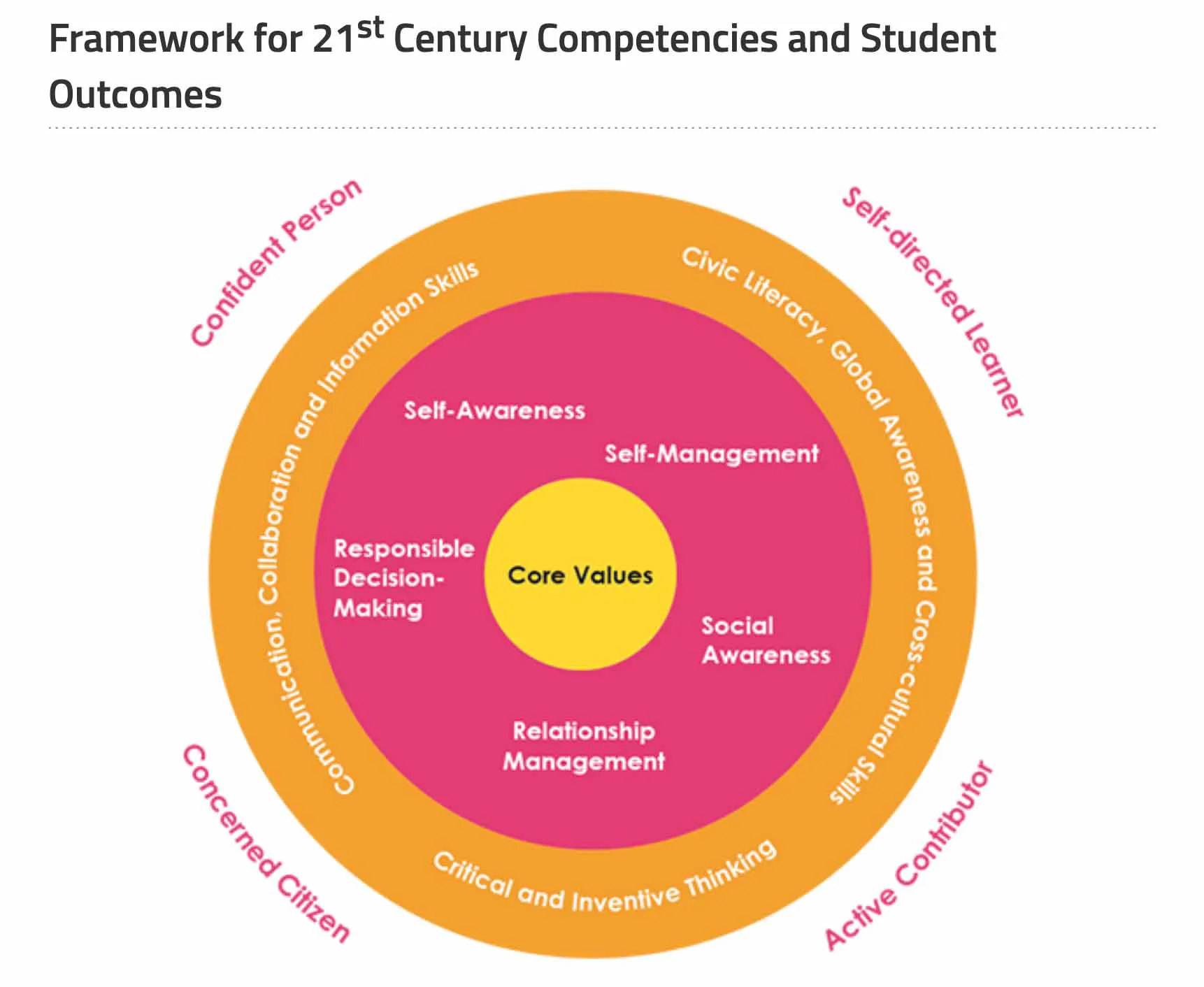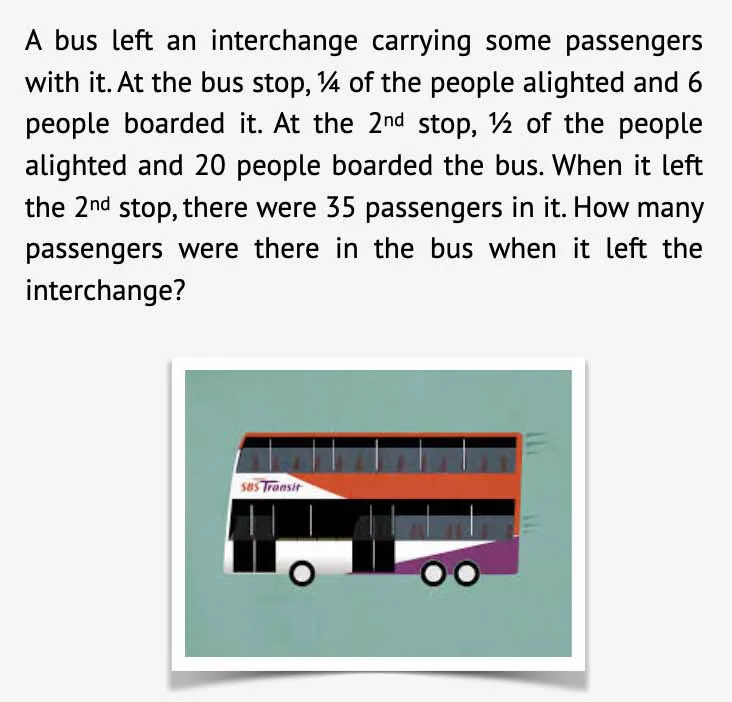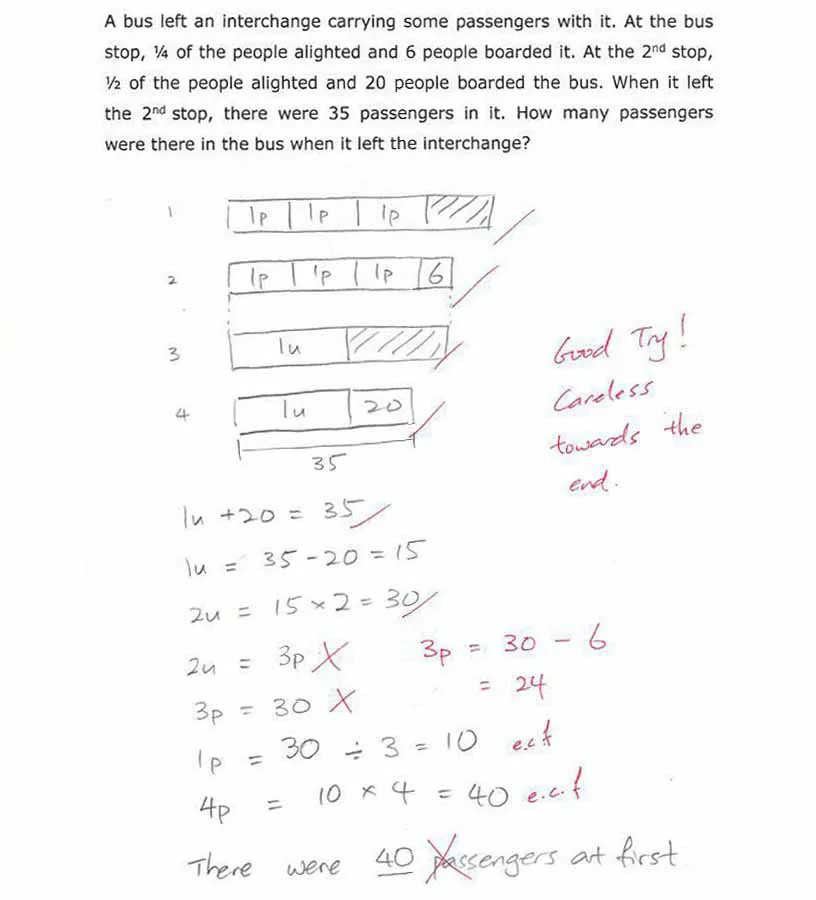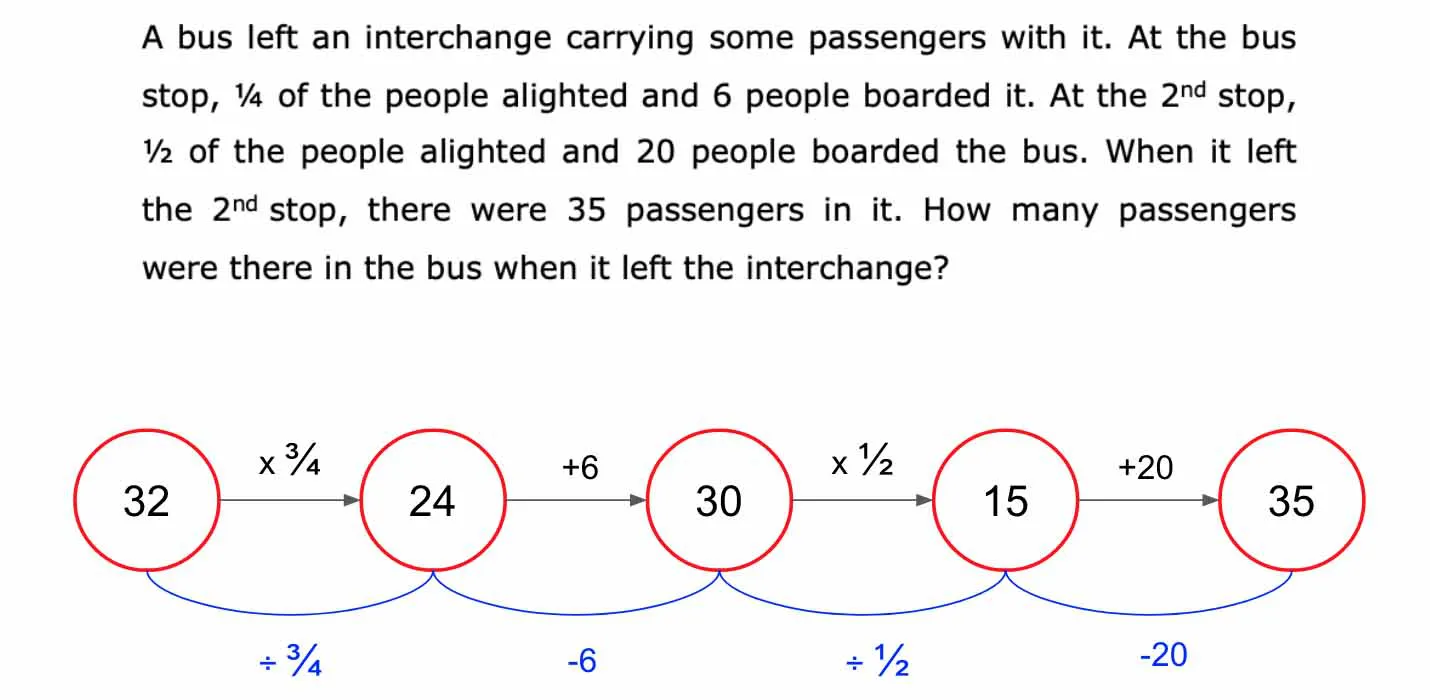Step 1: Understanding MOE’s 21st Century Core Competencies
Step 2: Blind Practicing Does More Harm Than Good
Step 3: Uncovering Hidden Gaps In Your Child’s Foundation
Step 4: Developing Strong Critical Thinking Skills
Step 5: 28 Problem Solving Strategies And Tools
Have you ever realised that your child’s math results are inconsistent and you are really worried that they may not be able to achieve their full potential? What if your child have been doing stacks of assessment books and putting in hours and hours of practice but are unable to see a substantial improvement in their grades? Or is your child coping well with Sections A and B but when it comes to Section C, they start to struggle and lose unnecessary marks?
Yes, it is true that MOE is placing emphasis on Critical Thinking Skills (CTS) as part of their 21st Century Core Competencies. That is why PSLE Math exam questions nowadays are not as straightforward and easy as they used to be.
So despite understanding the concepts and practicing hard before the exam, students typically take the long, drawn-out approach in solving exam problems. This is not only a waste of precious exam time but also exposes students to a higher risk of making careless mistakes.
Here at Tutify Education, we specialise in helping students improve 2 grades within 6 months through our PSLE math tuition course. We have 28 strategies and tools to help students solve problems with speed and accuracy. That is why parents say we are the best math tuition centre in Singapore. In this article, your child will learn a strategy that will immediately help him or her gain an extra 10 marks in the Maths exam.
Step 1: Understanding MOE’s 21st Century Core Competencies
In recent years, PSLE maths questions have been known to cause anger and frustration among many parents. The most recently concluded math PSLE paper held on 27 Sep, 2019 is a testament to this fact – it was apparently very tough. It seems to have affected the students so badly that one mother in Singapore took to Facebook to pen an open letter to Minister for Education Ong Ye Kung. She claimed the it was so “harrowing and so devastating” that her son and other children “came out of it defeated, crushed and utterly demoralised” and he was not the only student who felt that way.
For the past 5 years, MOE has been placing more and more emphasis on critical and inventive thinking. This is a quote from former Senior Minister of State for Education, Indranee Rajah:
Students today need to have critical and inventive thinking skills to thrive in a complex world, where jobs now require non-routine analytical and interactive tasks.
Senior Minister of State for Education Indranee Rajah
Critical and Inventive Thinking tests your logical reasoning and creativity. It is the ability to make connections and think outside the box. And it’s the most important skill your child needs to master to be successful not only in school but also in the future workplace.

Since 2016, as part of its 21st Century Core Competencies, MOE has been focusing a lot on adding tough, non-routine questions into the PSLE – to test students on their ability to make connections between different patterns and topics. The ability to make connections between different patterns and topics is, in short, Critical Thinking Skills (CTS).
Now, this is something you may not realise but this is biggest reason why, increasingly, MOE has been inserting a lot of Math Olympiad (MO) questions into the PSLE to test students on their critical thinking skills. And it’s used mainly to separate the A* students from the A and B students.
And judging by the recent trend, it’s highly likely that there will be more of such questions for PSLE this year and in the coming years. The question is, will your child be able to solve such questions when it comes out?
Step 2: Blind Practicing Does More Harm Than Good
Many parents believe that math is all about practice. However, blind practicing without finding the right approach does more harm than good. Let me explain:
In Primary 3 and 4, when the difficulty level is low and questions are not that complex, students may be able to breeze through their exams without realising there may be some hidden gaps in their concepts. By the time they get to Primary 5, when there is a big jump in difficulty, the content is much more, the pace is much faster and the questions are much more complex. That’s when students will start to see cracks under pressure.
That is why it is very common to see students drop 20-30 marks when they are promoted from Primary 4 to Primary 5.
In order to keep up, some students resort to just memorising steps and formulae. This results in a superficial understanding and gives the illusion that they know the content. So this is why students can solve the questions that are being taught in class, but when the questions are tweaked a little or becomes slightly different they get stuck.

This is due to the gaps in their understanding – and if these gaps are not fixed, no amount of practice or primary math tuition will help them get more than a B or C grade.
Step 3: Uncovering Hidden Gaps In Your Child’s Foundation
The key to achieving substantial improvement in your child’s maths results is practice with understanding.
One thing that is preventing most students from scoring A* is that they are wasting a lot of time on ineffective practice. There are some parents who give their child a lot of past year papers from the top schools to practice before the exam. So we let the child do the paper, mark it, then do corrections. And the process repeats itself. But even after doing this for weeks, there is not much significant improvement.
What your child needs is a customised road map to score AL1 (A*) for PSLE. If your child is already good in a certain topic, there’s no point getting him to do the same topic over and over again. On the other hand, if your child always struggles with a particular topic, then understand where are the gaps in his learning before moving on.
So look through your child’s past exam papers and make a list of their weaknesses.
From which topics are the concepts they do they not understand?
Which strands or sub-strands are they struggling with?
Which strategies or heuristics have they applied in the wrong context?
Once this has been accomplished, design a customised curriculum to help your child develop his or her foundations in a progressive way.
At Tutify Education, we first identify the gaps and weaknesses each student may have during our PSLE math tuition classes. Then, we create a personalised roadmap to help your child fix gaps in their foundations by clarifying their concepts. After that, we build competence and confidence through structured and progressive practice.
Best Math Tuition Practices
Here’s what happens in our weekly PSLE math tuition classes. First, we begin by working on conceptual questions (Level 1). Then, we move on to slightly more difficult application questions (Level 2), where students are expected to apply some strategies in solving the problem. The next level of progression will be stretching questions, where the questions are tweaked and CTS are required to solve them – most students struggle here. Finally, we reach the cross-topic questions.
Cross-topic questions are questions tests a student on more than 1 topic in the same problem. Needless to say, deep understanding and mastery of each topic is needed in order to solve them. These types of questions are the ones that separates the A* and the A/B students.

Step 4: Developing Strong Critical Thinking Skills
A common myth among parents is that their child has to be a genius in order to achieve an AL1 (A*) for Mathematics. Although it is true that MOE’s 21st Century Core Competencies places great emphasis on Critical Thinking Skills (CTS), students who do not have strong CTS can still develop it as long as they find the best math tuition centre in Singapore with the right approach.
This is the biggest difference that separates the A* from the B students:
The A* Student Thinks Of Creative, Out-Of-The-Box Ways To Simplify The Problem
The A/B Student Thinks Of Which Method Their Teacher Had Taught Them To Solve The Problem
The thought process of someone who is trained in CTS is vastly difference from that of someone who is not. But unfortunately, developing critical thinking requires a special kind of training. Most parents don’t know this but, it must be trained in the context of mathematical problem solving. That is why sending your child for stand-alone critical thinking class is not so effective for solving problem sums. Many parents often send their children for critical thinking enrichment classes when they were young. But unless it’s taught in the context of math problem sums, it’s usually a waste of time & money. And that’s why many students don’t see great improvement even after attending a lot of critical thinking classes.
There’s actually a very specific way to train critical thinking. Some say critical thinking is very vague and take a long time to see noticeable results. But the truth is, if trained in the right way, someone who has underdeveloped skills can improve very quickly in just a couple of months. Most importantly, you can actually see big improvement in your child’s grades as a result of this training. After training students in critical thinking skills to prepare them for Math Olympiad competitions, we’ve developed the most effective way to train critical thinking. Our teaching approach is specially designed to help students develop critical thinking in solving Math problems. We actually have a very specific training process that has been tested and proven. This is how we help our students to score AL1 (A*) in just 6 months or less.
Primary Math Tuition Course
Each week at Tutify Education, we conduct lessons in such a way that develops students’ logical reasoning and creative thinking skills. We’re the only maths tuition centre in Singapore with a strong and proven CTS training process that is developed by Coach Leo, specifically targeted at Mathematical problem-solving and in-built into our curriculum.
This is the biggest reason why our students see rapid improvement in their Maths results. When your child joins us today, they can expect to see quantum leaps in their results.
Step 5: 28 Problem Solving Strategies And Tools
However, CTS alone are not enough. Students need to be equipped with the right tools to solve problems faster under exam conditions. So, we have developed some simple but powerful strategies in order to help students to solve problems quicker, with a more simplified approach. Not only that, it decreases their risk to making careless mistakes.
Earlier on, we said that in this article, your child will learn a strategy that can immediately help him or her gain 10 extra marks in the Maths exam. So here’s 1 problem solving strategy you can teach your child to help him maximise his results. Take this question for example:

It is very common to see such a sum in the exam. Notice that the typical solution makes use of models along with several lines of workings. It is long and complex. Students tend to make careless mistakes in the process.

Here is the type of approach we encourage students to use. Notice that the models and workings are combined into a linear framework and all that’s needed are 5 steps to solve. This is more organised and efficient.

Can you see why this strategy helps us solve the problem faster and easier? Not only that, it will make us less prone to careless mistakes. This is only 1 of the 28 strategies and tools we have here at Tutify Education. Imagine if your child is able to master all the tools and solve any type of problem sum with speed and accuracy.
Conclusion
As you can see, right approach can make a huge difference in helping your child to secure an A* for the Math Exam. Building a solid foundation without any gaps, developing critical thinking skills and equipping students with advance strategies and tools to solve questions faster, easier and more accurately takes time, dedication and a proven approach.
After helping hundreds of students to score AL1 (A*) for the past few years, we know that our approach have been proven to work. This is why parents say we are the best math tuition centre in Singapore!



Hi, this is a comment.
To get started with moderating, editing, and deleting comments, please visit the Comments screen in the dashboard.
Commenter avatars come from Gravatar.